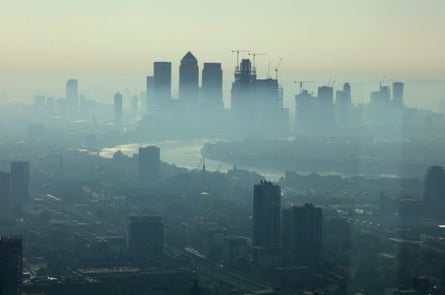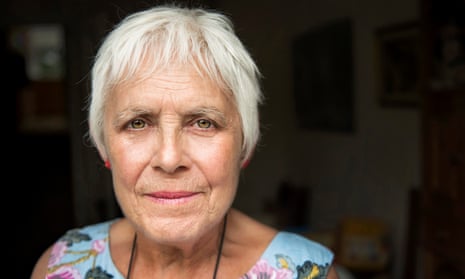Catherine Bazell looks out from her first floor flat towards the familiar landmarks of central London as a steady stream of cars and vans trundle by on the road below.
“Me and my mum and dad used to love taking bus trips for the day when I was a girl,” says the 73-year-old. “We would get a bus and just go off exploring different bits of the city.”
Bazell pauses for a moment before adding: “I wish I could do that now with my granddaughter but there’s no way, the pollution is just too bad.”
Bazell was born in London during the second world war and suffers from the debilitating lung condition bronchiectasis as well as asthma, leaving her all but housebound during the worst bouts of air pollution.
“I was born with a bad chest but it slowly started to get better when they brought in the Clean Air Act [in 1953] and we got rid of the coal smoke and all that … but in the last 15 or 20 years it is back and worse than ever.”
Bazell is one of hundreds of thousands of people whose lives are blighted by the UK’s air pollution crisis. Officials say at least 40,000 people die prematurely in the UK – 9,000 in London – with many more suffering long-term health problems.
A spate of recent reports have underlined the scale of the crisis; asthma deaths are up; hospital admissions spike when air pollution worsens; children living in polluted areas are likely to grow up with smaller lungs and risk of lifelong health problems. And it is not just people’s lungs that are at risk – toxic air is increasingly linked to a range of deadly conditions including heart disease, Alzheimer’s and Parkinson’s.
“Almost every week we are seeing more evidence of the damage air pollution is doing to the nation’s health,” said Alison Cook, director of policy at the British Lung Foundation . “It’s simply unacceptable that people in towns and cities across the country – particularly the young, the elderly and those with existing lung conditions – are being given no choice but to breathe dangerously dirty air in 2018.”
The government claims to be tackling the issue but many experts say it has repeatedly failed to take meaningful action. Ministers have refused calls for a new Clean Air Act and the government has been dragged through the courts over its record – and repeatedly been told by judges that its plans are so poor they are illegal.
However, some cities are starting to face up to the challenge. In Manchester the mayor, Andy Burnham, has said air pollution is one of his priorities and earlier this year he unveiled a far-reaching programme to encourage cycling. A host of other cities – including Birmingham, Leeds, Derby, Nottingham and Southampton – are working on proposals for clean air zones following the government’s latest court defeat.
But the most ambitious scheme is in London, where the mayor, Sadiq Khan, is planning an “ultra low emissions zone” (Ulez). The proposal will see the most polluting vehicles charged extra for entering the centre of the capital from April next year. In 2021 the zone will be extended to include all the roads within the North and South Circular, which officials predict will affect 100,000 cars, 35,000 vans and 3,000 lorries each day.
The plan has been batted back and forth between officials at Transport for London (TfL) and City Hall for five years. The final proposals unveiled in June show diesel cars – the main source of NO2 pollution – will have to pass the Euro 6 emissions standard [broadly those registered from 2014] and petrol cars the Euro 4 standard [those built after 2005] to avoid the daily £12.50 charge. There will also be restrictions on vans, buses and lorries.

The scheme has been broadly welcomed by environmental groups and clean air campaigners. However many say the restrictions should be tougher, since the limit on diesel vehicles will still allow some of the worst polluting cars and vans on the road. And many believe the scheme should cover a wider area and be brought in sooner.
Caroline Russell, who sits on the London assembly for the Green party, said Khan’s plans were “thorough and comprehensive” but she urged him to go further, quicker and “be braver.”
Russell, who chairs the environment committee on the assembly, says there is no reason the expanded zone should stop at the North and South circular, arguing it should stretch to include London’s outer boroughs up to the M25. And she said the new system should be based on a road pricing scheme, allowing vehicles to be charged differing amounts depending, not just on emissions, but also on which roads they are using at what time of day.
“We have a real chance to do something that will transform this city – to leave behind our old-fashioned reliance on fossil fuel, private vehicle-based transport in favour of a modern forward-looking system based around efficient, accessible public transport, walking and cycling.”
The expanded Ulez area will be enforced using number plate recognition cameras that will automatically charge cars that flout the emissions limits a daily rate – a similar system to the existing congestion charge zone. As well as monitoring NO2 pollution it will also include a “particulate matter standard”, after the Guardian revealed every part of London exceeds World Health Organization air quality guidelines for PM2.5 – the most dangerous particulate.
And the plans have even got the backing of many of the major motoring groups . The RAC said it “could not fault the mayor’s crusade to tackle air pollution”. Private hire firms Addison Lee and Uber both welcome the move.
However black cabs, which according to TfL figures are responsible for 20% of NO2 pollution in central London, will be excluded. This has led to criticism that the mayor is not tackling one of the key polluters. Officials point out that since the beginning of 2018 all new black cabs have to be electric, although old ones will be allowed to continue running for 15 years.
Steve McNamara, general secretary of the Licensed Taxi Drivers Association, says his members would be happy to be included in Ulez as long as private hire firms such as Uber are only allowed to buy electric vehicles too.
“All we want is a level playing field … we really don’t want to be driving round in these dirty vehicles, we just need a fair deal to get out of them.”
Despite the widespread support for Khan’s plans, some residents are sceptical of the mayor’s commitment to cleaning up London’s air. They point to the Silvertown tunnel development – a new crossing under the Thames in east London – which was given the go-ahead this year.
Local resident Darryl Chamberlain said Khan’s support for such a big road-building programme made a mockery of his claims to be serious about tackling pollution.
“He [Khan] is a world-class hypocrite,” said Chamberlain. “The Silvertown tunnel will increase traffic and pollution for London and particularly for local people but they have just ignored our concerns.”
Many want the mayor to go further, faster, but most argue that after the inaction of his predecessor, Boris Johnson, London is at last heading in the right direction.
Back at her flat, Bazell says that if the pollution today was as visible as it was when she was a girl people would be up in arms.
And she says that although she tries to live an active life, her world is increasingly shaped – and restricted – by the poisonous air she breathes.
Looking out to the distant London landmarks, she says: “I rarely go into central London any more. There are a few buses or trains I can get to visit family if the pollution is not too bad, but it is not that easy.”
Bazell says that a few weeks ago she had to miss her choir session at the local hospital because the pollution was so severe.
She looks up with a smile. “It comes to something when the air is too dirty to sing!”
